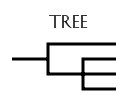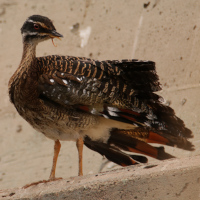
AVES
Neoaves IV
Chapter Outline
- Description of Aves
- Classification of Aves
- Palaeognathae
- Neognathae
- Neoaves I
- Neoaves II
- NeoavesIII
- Neoaves IV
- Telluraves
- Coraciimorphae
- Australaves
- Passeriformes

NCBI Tree | Paleo Tree
Links to external sites will appear in pop-up windows.
Anomalogonates is split into four groups and this page focuses on the four orders in the first split, Coccyges.
- Neoaves
- Aequornithes [37-V]
- Mirandornithes [37-V]
- Charadriiformes [37-VI]
- Gruiformes [37-VI]
- Opisthocomiformes [37-VI]
- Otidimorphae [37-VI]
- Columbimorphae
- Columbiformes - Doves and Pigeons
- Pterocliformes - Sandgrouses
- Mesitornithiformes - Mesitornithidae
- Phaethontimorphae
- Eurypygiformes - Sunbitterns, Kagu
- Phaethontiformes - Tropicbirds
- Strisores
- Apodiformes - Swifts and Hummingbirds
- Caprimulgiformes - Nightjars
- Telluraves [37-IX - 37-XII]
| COLUMBIFORMES | |
The order of Doves and Pigeons. As of 2024, 21 species of Columbiformes have been observed in iNaturalist in the US and 314 throughout the world.
|
Resources: |
| PTEROCLIFORMES |
Sandgrouses
|
Resources:
|
| MESITORNITHIFORMES |
There are three species in the order Mesitornithiformes.
|
Resources:
|
| EURYPYGIFORMES |
Subitterns were formerly in the order with Cranes.

Sunbittern (Eurypyga helias)
Sedgwick County Zoo - 2021
St. Louis Zoo - 2022
|
Resources:
|
| PHAETHONTIFORMES |
Tropicbirds were formerly in the order with Pelicans.
|
Resources:
|
| APODIFORMES | 9, 7 |
The order of Swifts and Hummingbirds. As of 2024, 46 species of Apodiformes have been observed in iNaturalist in the US and 477 throughout the world.
In the family of Swifts, Apodidae, 8 species have been observed in iNaturalist in the US and 108 throughout the world. In the family of Hummingbirds, Trochilidae, 38 species have been observed in iNaturalist in the US and 369 throughout the world.
Swifts can be found throughout the lower 48 of the U.S. but not in any zoos. The most commonly observed species in iNaturalist is the Chimney Swift (Chaetura pelagica), which ranges east of the Rocky Mountains. The second-most observed species is the White-Throated Swift (Aeronautes saxatalis), which ranges in the western U.S., almost exactly where the Chimney Swift does not. Vaux's Swift (Chaetura vauxi) and the Black Swift (Cypseloides niger) are also commonly observed and are found in the West.
Between Joshua Tree and Yosemite, in Trip 7, all three of the commonly observed western swifts can be experienced. The Chimney Swift is common at Cheyenne Bottoms in the Fall.
Resources:
|
| CAPRIMULGIFORMES | |
The order of Goatsuckers, Nightjars, Frogmouths. As of 2024, 9 species of Caprimulgiformes have been observed in iNaturalist in the US and 120 throughout the world. In iNaturalist, the previous two orders (Apodiformes and Trochiliformes) are included in Caprimulgiformes.
At Konza Prairie, Common Nighthawks (Chordeiles minor) dive in display. Their wings cause turbulence when they come out of their dive and it makes a buzzing noise.
|
Resources: |
| [ Previous Page ] | [ Next Page ] |